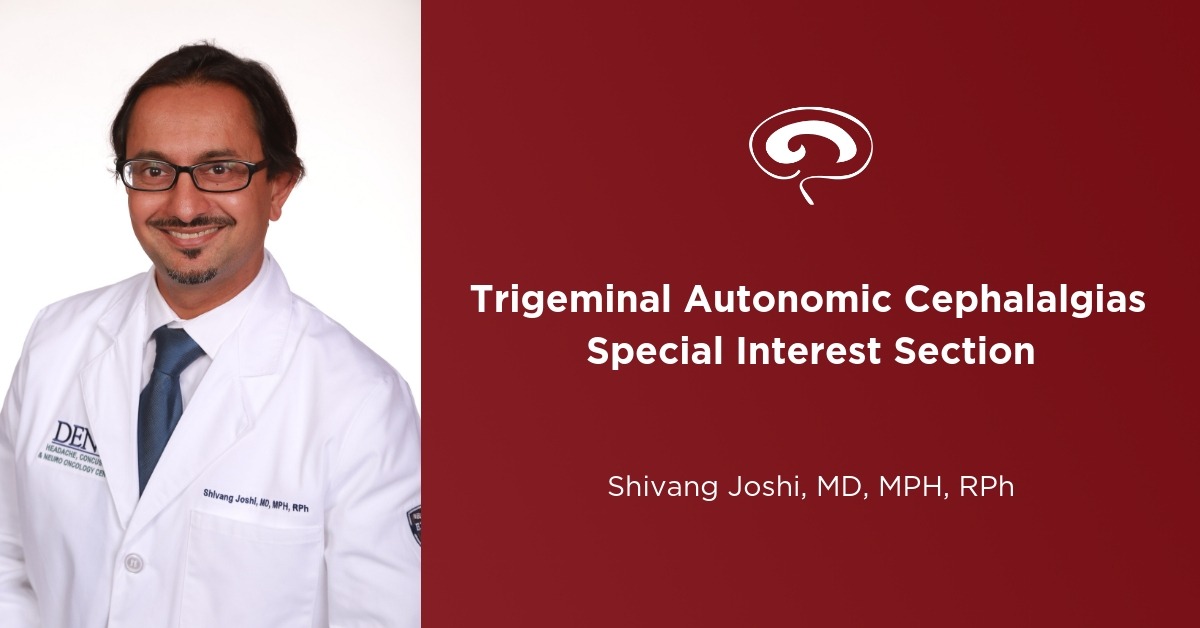
Special Interest Section Profile: Trigeminal Autonomic Cephalalgias
How the Trigeminal Autonomic Cephalalgias Special Interest Section is raising awareness on headache disorders
The American Headache Society is home to a diverse set of Special Interest Sections that connect members with shared expertise and an interest in collaborating on research efforts, developing practice models and providing multidisciplinary participation in support of the Society’s mission.
The focus of the Trigeminal Autonomic Cephalalgias Special Interest Section reflects the Society’s broader goal of honing our understanding of causes and treatments for all headache disorders. By raising awareness, encouraging research and advocating for better care of patients who live with TACs, the Trigeminal Autonomic Cephalalgias Section works to improve the field’s understanding of headache pathophysiology and ensure the best possible care is provided to patients.
We met with Section Chair Shivang Joshi, MD, FAHS, to discuss the group’s ongoing work and its vision for the future.

Name of Special Interest Section
Trigeminal Autonomic Cephalalgias
Number of Members
About 60
Name of Section Chair
Shivang Joshi, MD, MPH, RPh, FAHS
What is the mission of your Special Interest Section?
We have several different missions. Within the Trigeminal Autonomic Cephalalgias, there is a severe—but rare—debilitating headache disorder called cluster headache, and there’s really not a lot of information or research on it that can be leveraged for treatment. We have a paucity of treatment modalities available for this very severe headache disorder. So what I’d like to do is get like-minded individuals who have a shared interest in Trigeminal Autonomic Cephalalgias, and in particular cluster headache, and create a think-tank to come up with ideas and projects that would further not only treatment for patients, but also education for physicians within the Society.
What are some recent projects your section has been a part of?
Our first meeting was at the 2018 Annual Scientific Meeting. We worked together and decided that we wanted to hear from patients first. What are the unmet needs from the patient perspective? I was able to attend a patient advocacy meeting for cluster headache called Clusterbusters. We were able to analyze that group’s input and determine what they expect from treatment. By using this information we were able to create a pre-course for TACs that was selected to present at the AHS meeting in Scottsdale 2018. The course was overwhelmingly successful. What was unique about the course was that we actually had patients present and give their perspective.
What are the future goals of this Special Interest Section?
We have several goals. One of them is to increase awareness of the group itself through multimedia advertisement and word-of-mouth, then we’d like to do more patient advocacy work. For example, one of the medications, or therapeutic agents, used to treat cluster headache is oxygen, which, unfortunately, a lot of insurance companies do not pay for. So we’d like to start advocating for that more. We’d also like to collaborate with other Special Interest Sections for joint research projects. For example, if a cluster headache patient went to the emergency room, what would their experience be? So we may collaborate with other Special Interest Sections to develop protocols for the emergency room for cluster headache patients. So protocol development, education, research and lectures are some of the future projects. Our more ambitious goal is to create a Cluster Headache Center of Excellence and have it sever as a model for others. Currently, there is no model for this in existence. This would ideally be done with further input from patients themselves and in collaboration with other experts in the field.
How is this Special Interest Section making an impact in the field of headache medicine?
We’d like to make an impact by creating awareness and education, first of all. And I think it starts with educating everyone—from medical students to primary care physicians—because a lot of these Trigeminal Autonomic Cephalalgias are often misdiagnosed as non-neurological issues and patients suffer for years. So I think an education campaign of creating awareness and influencing earlier detection and diagnosis of some of these headache disorders may impact patient burden overall.
The mission of the American Headache Society is to be a global leader in championing scientific research, as well as educating researchers, healthcare professionals and the public. We’re grateful to the Trigeminal Autonomic Cephalalgias Section for actively working to advance these goals. By helping our members collaboratively pursue their interest in Trigeminal Autonomic Cephalalgias and use their knowledge to advocate on behalf of patients, the members of this Special Interest Section are ensuring that the American Headache Society will remain a valuable educational and advocacy resource for migraine patients and the public.
If you are an AHS member who would like to get involved in the Trigeminal Autonomic Cephalalgias Section, get in touch.


